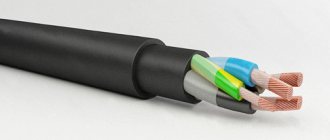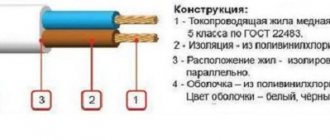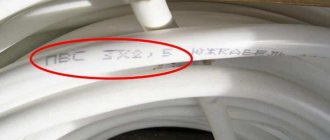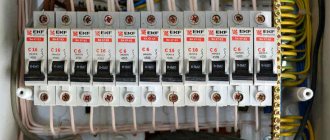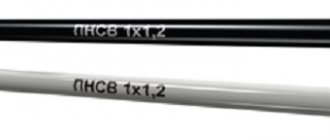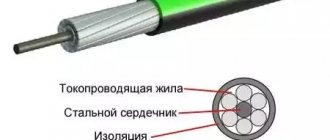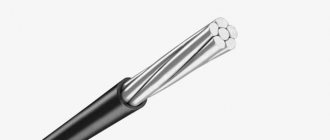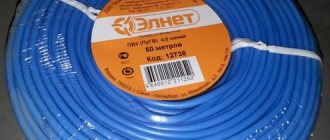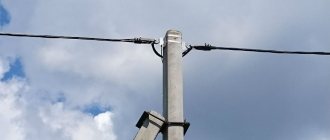There are a huge number of manufacturers in the world producing a variety of cable products. Some products are necessary for connecting low-power household appliances, while others allow you to switch large equipment or supply huge construction sites with electricity. The PPV wire is something in between.
The electrical product is used when installing lighting systems and organizing fixed wiring. However, this does not prohibit its use for switching other electrical mechanisms and units.
The operating voltage of the PPV should not exceed 450 V when connected to an alternating current network or 1000 V if it is a source of constant electricity. The current frequency is 400 Hz.
How to decipher PPV wire
Each letter of a product means its properties and composition. The abbreviation PPV is very easy to decipher and can be read as follows:
- “P” – the first character means that this product is a wire (if the name does not contain the letter A, then the wire is made of copper);
- “P” – flat type of wire (without this sign the product would have a round cross-section);
- “B” - indicates the outer shell of PVC material;
- “ХЛ” – additional symbols that indicate that the wire can be used in different climatic zones (heat, cold).
What the product looks like
In addition to the letter value, the marking may contain numbers. Which means the cross-sectional area, the number of cores and the length of the product.
For example, we can cite the PPV 5x3-220 wire - this indicates that it contains five copper wires with a cross-section of 3 mm² each, and the product can be used for networks with a voltage of 220 Volts.
The most popular types of PPV wire:
- 3x1.5;
- 2x1.5;
- 3x2.0;
- 3x2.5;
- 3x4.5.
Important! The larger the cross-sectional area of the cable, the more expensive it will cost.
PPV wire technical specifications
Design features
In addition to the parameters clear from the decoding of the name, the SHVVP wire has other design features.
- Cross-section of current-carrying conductors. According to GOST 7399 - 97, the ShVVP cord can be produced in two modifications - with cores of 0.5 mm² and 0.75 mm². Therefore, this product is not intended for connecting high-power electrical appliances. Some manufacturers produce wire with a cross-section of up to 6 mm², but such conductors are not standardized by the above GOST, so the quality of these products remains on the conscience of the manufacturers.
- The number of conductive cores in the cord. According to regulatory documents that determine the quality of the product, one cable can contain 2 or 3 separate wires with a cross-section of 0.5-0.75 mm².
- Construction of current-carrying conductors. A cord is by definition flexible, so the wires that make it up must be made of several thin copper strands. In the case of a SHVVP cord, individual wires according to GOST 7399 - 97 must consist of 7 single-core copper wires. Their diameter depends on the cross-section of the wire - 0.33 for a 0.5mm² core and 0.38 for a 0.75mm² core.
- Insulation thickness. To ensure trouble-free operation of the cord, the thickness of the cable insulation and individual wires must comply with regulatory documents. For this product it should be no thinner than 0.5 mm, and for the general shell no less than 0.6 mm.
- Color of individual veins. The color marking of the wires must comply with the PUE clause 1.1.29 and is determined by GOST 7399 - 97. Brown sheath is phase, blue is neutral, yellow-green is grounding. The outer insulation is usually white, but sometimes black cord is found. This does not change the price of the product.
Product technical parameters
The main technical parameters that can be used to describe the wire will be the constant resistance per 1 km of the product and the resistance of external insulation at a temperature of 15 degrees.
The temperature range for normal operation is from -50 to 70 degrees. At a critical temperature of 170-200 degrees, it is necessary to turn off the power to the wire to prevent a short circuit.
Current conductivity depends on what cable cross-section was chosen.
Important! If the cable cross-section is too small for a particular network, the wire will begin to heat up, which may result in a fire or short circuit.
Due to the too close arrangement of the wires, the permissible power limit and permissible current loads are significantly reduced.
Thus, before purchasing a wire, it is necessary to calculate the amount of power that will be consumed by electrical devices installed on the current section of the circuit. The electrical strength of the product depends on the material of manufacture and the thickness of the insulating layer. With a cross section of no more than 1 mm, it is 0.6 mm, from 1.5 to 4.0 - 0.7 mm.
You might be interested in this All about SIP-4 wire
Other technical specifications can be found in the product specifications.
Cable design
Selecting conductor cross-section for current and power
The diameter of the conductor is selected based on the expected power of the electricity consumer (the total power of several objects) or the current load of the network. To save user time, the recommended parameters are summarized in the table:
| Section, mm² | Mains voltage, V | Current, A | Power, W | Mains voltage, V | Current, A | Power, W |
| 1,5 | 220 | 19 | 4,1 | 380 | 16 | 10,5 |
| 2,5 | -//- | 27 | 5,9 | -//- | 25 | 16,5 |
| 4,0 | -//- | 38 | 8,3 | -//- | 30 | 19,8 |
You can determine the cross-section of the core using the ratio to its diameter (with a hyphen):
- 1-1.1mm;
- 1.5-1.4 mm;
- 2-1.6 mm;
- 2.5-1.8 mm;
- 4-2.3 mm.
When choosing a wire, you need to know the network load and have a caliper with you
Scope of application of PPV cable
This product is often used for laying electrical wiring and power plants. Suitable for use in panels with a constant voltage of 380 W and a frequency of up to 350 Hz. If alternating current, then the wire is used at voltages up to 1000 W.
The scope of application depends on what the outer layer of the cable is made of. The wire can be used for permanent and inflexible installation. It is advisable to lay the PPV cable in corrugations and cable ducts. The scope of application is quite wide, even in industry or nuclear power plants. The main places where the PPV cable is used:
- Wiring outside the premises;
- Residential and office buildings;
- Industrial enterprises.
The same wire is used for machine tools, apparatus, lighting devices, and electrical installations.
Cable marking
The main advantages of using PPV cable for wiring:
- If the wire is placed inside a concrete wall and disguised under a layer of finishing material, it will have high fire safety. This is explained by the fact that air does not circulate inside the wall and therefore combustion will not spread;
- The cable is protected from touch and careless mechanical influences. Hidden laying allows you to increase the service life of the wire, because exposure to negative environmental sources is eliminated;
- When laid hidden, the cable will not spoil the appearance of the room.
But this product has its disadvantages:
- If a mistake is made when laying the wire hidden, you will have to open the entire wall to get to it. As a result, you will have to repair the wall again, and this is not cheap;
Three-core PPV
- Extension of cables by twisting leads to an increase in resistance and the formation of sparks, especially if powerful equipment is connected to the network. Because of this, the cable overheats greatly, which can lead to a fire;
- Problems that appear during the search for cables or when installing old wiring. You have to break down the entire wall to find the wire.
Comparative analysis of flat wires with copper and aluminum conductors
The purpose, structure, and method of laying PPV and APPV are absolutely similar. But there are a number of circumstances that favor the use of wires with a copper conductor:
- strength, fracture resistance;
- resistance to temperature fluctuations and overheating;
- smaller cross-section of conductors for connecting an equal load.
However, APPV can counter the comparative lightness of the product as well as the lower cost. Therefore, it is impossible to make a clear choice regarding one product or another.
Practical advice: when connecting electrical installations or arranging electrical wiring in active premises, where electricity consumption may unexpectedly increase due to an increase in the number or power of connected devices, it is better to use copper wires. For lighting networks and wiring in less critical buildings, you can use APPV, saving on the cost difference.
How to choose the right PPV cable
The first step is to decide from what composition to choose the cores.
Most electricians prefer copper conductors. The main advantage is that copper consumes less aluminum and also has a longer service life.
Important! Copper products will be more expensive, but they fully pay for themselves with their safety.
You can purchase wires of mixed types, made of copper and aluminum. But then, you need to combine them using a terminal block.
Terminal blocks for combining
If the wires come into contact with each other for a long time, they will quickly oxidize and their resistance will increase. Because of this, the cable quickly heats up and fails. In the worst case, contact may result in a fire at that point.
You may be interested in this Features of electric flooring
Next, the wire is selected for flexibility and rigidity.
A rigid product mainly consists of one core, and a flexible one consists of many.
Important! The greater the number of wires inside the cable and the smaller each wire, the softer the product will be.
Flexibility can be divided into 7 categories, single-core is category 1, and stranded is category 7.
Dangers of use
It is unacceptable to use the cord for several household appliances connected to it at the same time. Even if their individual power is small, it may turn out that the total power exceeds what is permissibly possible for ballast cables, the characteristics of which are not designed for a continuous current load exceeding 6 A.
For example, using such a cord, even with a cross-section of 0.75 mm2, we connected an outlet in the kitchen. Using a tee, a microwave oven, an electric kettle and an electric stove were simultaneously connected to it. The average power of connected consumers is:
- stove - 2.5 kW;
- microwave – 1.8 kW;
- electric kettle – 1.2 kW.
The total power of three household appliances will be 5.5 kW. With a network voltage of 220 V, the total current consumption will be equal to 25 A. This means that when the devices are turned on simultaneously, the current value will exceed the permissible value by 4 times. The wire will not hold up and will burn, which can cause a general fire.
There are several common reasons why the rule for using such a cord is violated, namely:
- imaginary ease of installation - flexibility;
- remnants of material that are a pity to throw away;
- double insulation.
Double insulation and temperature range (-25-+400C) are misleading to the average person, but should not confuse a specialist. The insulation is not thick enough, and moisture and temperature changes can damage it if the wiring is exposed. In any case, GOST-7399-97 and OKOF 143131040 prescribe not to use this electrical product to power stationary power units (PS).
Attention! For control systems, power cables and wires with conductors of a suitable cross-section, insulation of sufficient thickness and a large current reserve are used. The flexible SHVVP cord will serve efficiently and for a long time if you do not violate the methods of its use
A correctly selected cross-section corresponding to the load power will ensure proper safety during its operation
The flexible SHVVP cord will serve efficiently and for a long time if you do not violate the methods of its use. A correctly selected cross-section corresponding to the load power will ensure proper safety during its operation.
Rules for connecting PPV
When laying wires, you need to remember several important rules:
- The stiffness of the wire directly depends on the number of cores.
- The bend radius during wiring should not exceed 10 outer diameters. Exactly 10 bends are allowed at right angles with a return to the starting point;
What does a copper core look like?
- If bends are not needed, then they should be avoided;
- PVC is a chemically resistant composition. Therefore, such cables can be laid through brick or concrete walls and disguised with finishing materials. When laying in the wall, you do not need to use corrugation;
- Many building compositions contain various impurities and additives, which over time can destroy the insulation shell. If the composition of the mixture is unknown, then it is better to place the cable in corrugations for additional protection;
- When laying PPV cable under plasterboard, plastic bases or laminated chipboards, it is necessary to use a cable channel;
- It is allowed to pull the wire through the air, but most craftsmen recommend using canopies or other systems to protect the wire from ultraviolet rays;
- Due to its hygroscopicity, PPV wire can be used in places with a high percentage of humidity (bath, sauna, steam room).
Important! Before connecting the cables, it is recommended for a beginner to study as much literature as possible and watch video tutorials on the Internet. But any experienced master will recommend seeking the services of professionals.
Corrugation for additional wire protection
Cable storage and transportation conditions
For any cable products, you must follow a number of rules for storage and transportation. Store wires only in a dry room with low humidity. Otherwise, mold or mildew may form on the product. It is advisable to make sure that there are no rodents in the warehouse that could damage the insulating layer. Storage is allowed at temperatures from 15 to 25 degrees. It is allowed to place cable reels outdoors, but away from direct sunlight.
Important! Cable drums must not be placed on their sides.
Checking the PRKA before installation
Before proceeding with wiring or connecting electrical installations, the wire is checked for integrity and absence of wire breakage.
The probes of the device are connected to the ends of the wire, the sound of the buzzer confirms the integrity
This operation is carried out using a “multimeter” device:
- to bring the device into working condition, the contact probes are connected to the corresponding sockets: black - “com”, red - VΩ;
- the switch is moved to the “diode check” indicator;
- the operability of the device is checked by contacting the probes with each other: the “continuity” sound signal should sound;
- Now the probes are applied to the ends of the wire (as mentioned earlier, the conductor is transported and stored in rolls, with the ends brought out for testing).
The sound of the buzzer indicates the integrity of the current-carrying conductor; the absence of a signal is a sign of a break.
Service life of PPV brand cable
The average service life of the product is 15 years. If there is any mechanical damage on it, then its service life is reduced. Laying is permitted only at temperatures not lower than -15 degrees.
You may be interested in: Permissible cable current
Proper storage in a reel
If it is frosty outside, the cable must be warmed up indoors before installation. If all storage and use rules are followed, the wire will be able to serve without overlays.
Characteristics
The technical and electromechanical characteristics of the PVS wire are regulated by the requirements of GOST 7399-97. It should be noted that this standard only describes a range of values, and actual parameters may vary from manufacturer to manufacturer. This means that exact data on the size, diameter of cores and wires, as well as the thickness of the insulating sheath should be obtained from the accompanying documentation or directly from the supplier.
- The temperature at which PVA wire retains its operational and technical performance at the highest level is in the range from -25˚C to +40˚C. If the wire marking indicates the “Y” version, the lower limit of the temperature range expands to -40˚C - +40˚C. It should be taken into account that during use the heating of the current-carrying conductors should not exceed +70˚C.
- PVA wire is resistant to combustion and does not spread fire when laid alone.
- The cable is designed for use in rooms with high relative humidity (up to 98%).
- When using PVA wire for laying electrical networks, its working life exceeds 5000 hours. If the cable is used in stationary electrical equipment - at least 12,000 hours.
- The cable's resistance to alternating deformation when bending (with a radius of at least 4 cm for a cross-section up to 1 mm2 and at least 6 cm for a cross-section greater than 1.5 mm2) and rated voltage is 30,000 cycles.
- Climatic cables (PVS-T) are resistant to mold and mildew.
- The PVS wire is intended for use in electrical networks with linear voltage from 380V to 660V.
- The warranty service life of the cable is 2 years and is counted from the moment it is put into operation.
A standard PVA wire can withstand alternating current with a voltage of 2 kW for 5 minutes. After immersion in water for 1 hour - up to 15 minutes. In terms of mechanical strength, it is close to the VVG cable - to break it is necessary to apply a force of more than 10 N/mm2, and before breaking the wire will lengthen by one and a half times.
The standard length of PVA wire on sale ranges from 30 to 200 meters. Most often it is sold in coils and cable drums.
Manufacturers of PPV brand wire
Currently, there are many factories producing cable products. To avoid buying a fake, it is recommended to choose the most reliable ones. If the consumer does not know which factory to give preference to, he can always visit the forum of electricians, who will tell you exactly which companies are most in demand.
When choosing cable products, you must pay attention to the certificate that the seller must provide. It states the manufacturing plant, the date of manufacture of the cable and the expiration date. If the seller refuses to provide this document, then the product may be counterfeit. Today there are more than 50 large factories, so before purchasing a product you need to study reviews about each of them.
Below is a list of leaders in the Russian market.
JSC "Electrokabel"
The plant was founded in the Moscow region in 1949 of the last century. Today, there are more than 100,000 thousand types of wire sizes available. The company cooperates with large companies in the Russian Federation and abroad, delivering by airlines and railways.
Manufacturing process
Kamsky Kabel LLC
A huge cable production plant is located in Perm. Produces cables for the largest enterprises in the country. The assortment includes more than 55,000 thousand types of products. The plant has gained wide popularity not only in Russia, but also abroad. Industrial factories in Asia and Europe use the services of this company. This manufacturer owns 14% of the entire cable business in Russia.
Important! The main advantage is that all products presented on the site are always in stock. The company quickly produces custom-made wires of any length.
OJSC "Sevkabel"
One of the oldest factories in our country, founded in 1879. The range includes more than 30,000 thousand standard sizes of wires. By the end of 2022, the enterprise plans to complete a large-scale modernization. The latest equipment is installed in the workshops, and there is also a testing center on the territory of the plant. Therefore, all products are of high quality. The plant has many awards and positive reviews.
Correct transportation
In conclusion, it should be noted that the PPV wire is often used for laying lighting in residential premises and connecting various equipment. The cable is used not only for domestic purposes, but also in industrial enterprises. During installation, it is advisable to seek help only from trusted professionals with extensive experience in this field.

